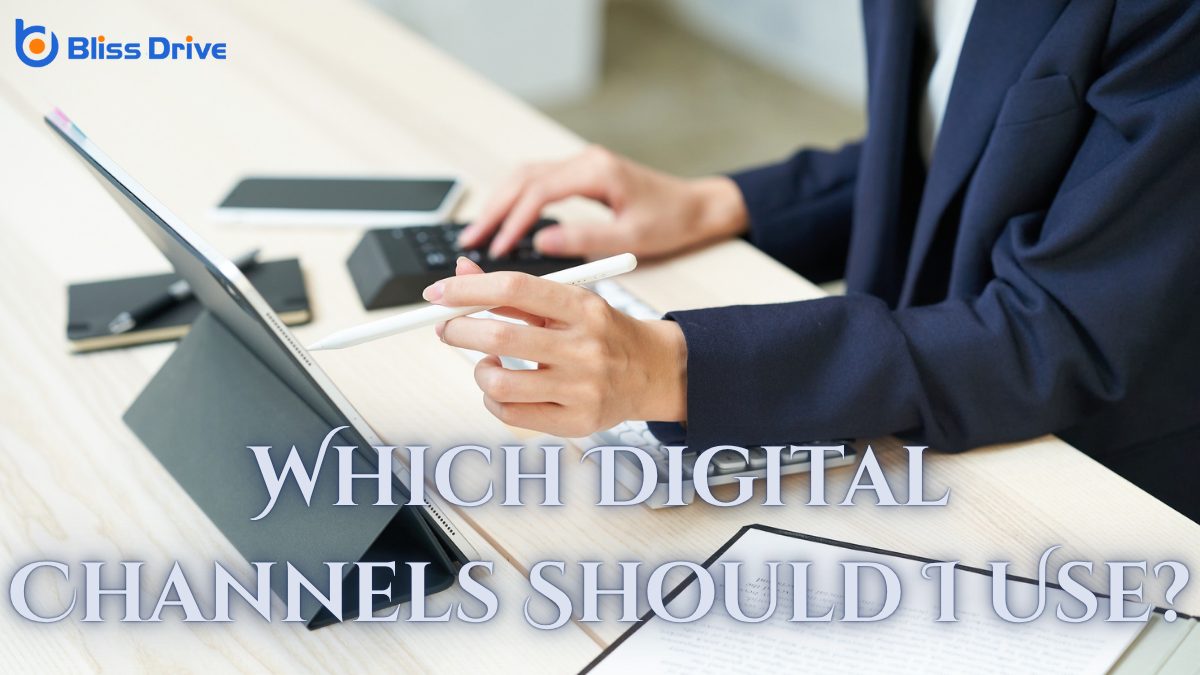Learn More About Us

When we're considering which digital channels to use for our marketing strategy, it's essential to focus on where our target audience spends their time. By aligning our choices with their preferences, we can enhance engagementThe interactions that users have with a brand’s content on social media. and guarantee our messages hit the mark. From social media to email marketingThe use of email to promote products or services, build relationships with potential customers, and ... and SEO, the options are vast. But how do we decide which paths to prioritize? Let's explore the key factors that can guide us in making the right decision.
Understanding our target audience is the cornerstone of any successful digital marketing strategy. When we truly know who we're speaking to, we can craft messages that resonate deeply. It's not just about demographics; we need to understand their behaviors, preferences, and pain points.
By doing so, we can tailor our content to meet their specific needs, making our messaging more effective.
To start, let's gather data from existing customers, surveys, and analyticsThe systematic computational analysis of data or statistics to gain insights and support decision-ma.... This information helps us identify patterns and insights about who they are and what they want.
We should create detailed buyer personas, representing segments of our audience. This enables us to visualize them as real people. Our goal is to connect authentically, speaking their language and addressing their unique challenges.

When we evaluate social media platforms, it's essential to understand the audience demographics each platform attracts.
By knowing who uses which platform, we can tailor our content to maximize engagement potential.
Let's explore how these factors can influence our digital strategy.
To effectively reach our target audience, we need to evaluate the demographics of various social media platforms. Each platform attracts different age groups, genders, and interests.
For example, InstagramA photo and video-sharing social networking service owned by Facebook. generally appeals to a younger audience, mainly between 18 and 34, while FacebookA social networking site where users can post comments, share photographs, and links to news or othe... has a more diverse age range, including older adults. LinkedInA professional networking site used for career and business networking., on the other hand, is favored by professionals, often in the 30-49 age bracket.
Understanding these demographics helps us choose the right platform to connect with our desired audience.
We should consider gender differences too—Pinterest, for example, sees a largely female user base.
By aligning our platform choices with these demographic insights, we guarantee our messages reach the right people, maximizing our digital marketing efforts.
Let's choose wisely.
How do we determine which social media platforms offerThe specific product or service being promoted by affiliates. the best content engagementThe level of interaction and involvement that users have with content. potential?
We start by analyzing user interactionAny action taken by a user on social media, such as likes, comments, shares, or retweets. metrics like likes, shares, comments, and reach. Different platforms have unique strengths. For instance, Instagram thrives on visuals, making it ideal for brands with strong imagery. Twitter's fast-paced nature suits real-time updates and conversations, while Facebook's broad user base allows for diverse content types.
To evaluate effectively, we need to take into account our target audience and content style. Are we aiming for quick updates or in-depth discussions?
Additionally, reviewing analytics toolsSoftware used to track and analyze website performance, user behavior, and marketing efforts. can provide insights into how our content performs across platforms. By aligning our objectives with platform strengths, we can maximize engagement and guarantee our messages resonate with the right audience.
Let's explore how we can effectively leverage email marketing by focusing on building robust subscriber lists and crafting engaging content.
We should also regularly analyze our campaignA set of ad groups sharing a budget, targeting options, and other settings. performance to understand what's working and where we can improve.
When it comes to building subscriber lists, leveraging email marketing is one of the most effective strategies we can employ.
First, let’s guarantee we’re offering value. Subscribers are more likely to join if they see clear benefits, like exclusive content or special offers. We must create compelling sign-up opportunities across our digital platforms—be it on our website, social media, or during events. A simple, user-friendly form encourages more sign-ups.
We also need to be transparent about what subscribers can expect, including frequency and content type. This builds trust and reduces unsubscribe rates.
To truly capture our audience's attention, we must focus on crafting engaging content that resonates with them.
Let's start by understanding our audience's interests and needs. By segmenting our email list based on demographics, past interactions, or preferences, we can tailor messages that feel personal and relevant.
It’s crucial to make our subject lines enticing yet clear, encouraging recipients to open our emails.
Once inside, we should aim to deliver value—whether through informative articles, exclusive offersSpecial promotions or discounts shared via email to incentivize subscribers., or compelling storytelling.
Our content should be concise, with a clear call-to-action guiding readers on what to do next.
Visuals, such as images or infographicsVisual representations of information, data, or knowledge intended to present complex information qu..., can enhance engagement and break up text.
Let's prioritize quality over quantity, ensuring every email adds value to our subscribers.
While crafting engaging content is essential, analyzing campaign performance is equally important to guarantee our efforts are successful. By leveraging email marketing analytics, we can gain insights into what resonates with our audience.
Let’s focus on key metrics like open ratesThe percentage of recipients who open an email., click-through rates, and conversionThe completion of a desired action by a referred user, such as making a purchase or filling out a fo... rates. Open rates tell us whether our subject lines are effective, while click-through rates indicate how compelling our content is. Conversion rates help us measure the ultimate success of our emails in driving desired actions.
We should use A/B testingA method of comparing two versions of a web page or app against each other to determine which one pe... to compare different strategies and refine our approach based on real-world data. By continuously monitoring and adjusting our tactics, we can optimize our campaigns for better outcomes.
Analyzing performance transforms data into actionable insights for future success.
As we explore content marketing opportunities, let's focus on the vast potential that lies in crafting engaging and valuable content.
Our aim is to connect with our audience on a deeper level and provide them with meaningful experiences. By leveraging content effectively, we can build brand loyalty, enhance customer engagementThe level of interaction and involvement a customer has with a brand., and drive conversions.
Here are some key strategies to draw our audience in and keep them interested:

As we explore the potential of search engine optimization (SEO), we must start with the backbone of effective SEO—keyword research.
By focusing on the right keywords, we can enhance our on-page SEOOptimization techniques performed directly on the website, including content and HTML source code. techniques to guarantee our content ranks well.
Additionally, building a strong network of backlinksLinks from other websites pointing to your website, crucial for SEO. will further boost our visibility and credibility online.
Keyword researchThe process of finding and analyzing search terms that people enter into search engines. stands as an essential pillar in harnessing the power of search engine optimization. By understanding the words and phrases our audience uses, we can tailor our content to meet their needs and improve our search engine rankings.
This process not only helps us attract the right visitors but also guarantees we're providing valuable information.
Here’s why keyword research matters:
Mastery of on-page SEO techniques is essential for enhancing our website's visibility and user experience. By focusing on elements like meta tagsHTML tags that provide information about a web page to search engines and visitors., headings, and URL structure, we can make our content more appealing to both search engines and users.
Let's guarantee our titles are catchy yet informative, enticing readers to click while clearly conveying the page's focus.
We should also pay attention to headers, which help organize content and guide readers through our pages. Using relevant keywords naturally within our content can improve search rankings without compromising readability.
Additionally, optimizing images by using descriptive file names and alt textDescriptions added to images to help search engines understand the content of images. enhances accessibility and searchability. By implementing these on-page SEO techniques, we can improve our site's performance and attract more visitors.
When it comes to boosting our site's authority and visibility, cultivating a robust backlink strategy is essential. Backlinks act as votes of confidence from other websites, signaling to search engines that our content is valuable.
To harness this power effectively, we should focus on building quality links rather than sheer quantity. Let's explore some effective strategies:
These approaches can greatly enhance our search engine optimization efforts.
How can businesses effectively reach their target audience in today's digital landscape? One powerful method is utilizing Pay-Per-Click (PPC)An online advertising model where advertisers pay a fee each time their ad is clicked. advertising.
When we use PPC, we can place ads in front of potential customers actively searching for products or services like ours. This guarantees our message reaches the right eyes at the right time.
With PPC, we only pay when someone clicks on our ad, making it a cost-effective strategy. To succeed, we must choose relevant keywords and craft compelling ad copy that resonates with our audience.
Monitoring campaign performance is essential, allowing us to tweak and optimize for better results. By leveraging PPC, we can drive targeted traffic to our website and boost our business's visibility and growth.
While the digital landscape continues to evolve, implementing video marketingUsing videos to promote products or services and engage with an audience. strategies has become essential for capturing audience attention.
We need to focus on creating engaging content that resonates with our viewers. Videos are an incredible tool to showcase our brand's personality and connect on a deeper level. By prioritizing video, we can boost engagement and drive conversions.
Here’s how we can effectively use video:
Let's embrace video marketing to communicate clearly and creatively, ensuring our message is both seen and remembered.

As we harness the power of video marketing to engage our audience, collaborating with influencers presents another dynamic opportunity to enhance our reach and impact.
By partnering with individuals who already captivate our desired audience, we can tap into their established trust and credibility. It’s essential to select influencers whose values align with our brand, ensuring authenticity in our collaborations.
Together, we can create content that resonates deeply with audiences, driving both engagement and conversions. Influencers offer unique perspectives and creativity, enriching our brand narrativeThe overarching story that communicates a brand's mission, values, and purpose..
By actively engaging with their followers, we can foster meaningful connections and expand our community.
Let’s embrace these partnerships, leveraging influencers' platforms to amplify our message and achieve greater visibility in the digital landscape.
To truly understand the impact of our digital marketing efforts, we must plunge into analyzing data and measuring success.
It's crucial to identify which strategies work and which don't. By examining metrics, we can adapt and improve our campaigns.
Here's what we should focus on:
Effective digital marketing requires us to align our digital channels with our business goals. When we guarantee our channels reflect our objectives, we maximize the potential of our marketing efforts.
Let’s start by identifying our primary goals. Are we aiming to increase brand awarenessThe extent to which consumers are familiar with the qualities or image of a particular brand., generate leads, or drive direct sales? Each goal might require different channels. For instance, if brand awareness is our focus, social media platforms like Instagram or Facebook might be ideal.
However, if generating leads is key, email marketing or LinkedIn could serve us better. By matching the right channels to our goals, we create a cohesive strategy that efficiently drives results.
Our digital efforts should always support our overarching business vision, guaranteeing alignment and success.
In choosing the right digital channels, we must focus on our audience's preferences and behaviors. By evaluating social media platforms, leveraging email, exploring content opportunities, and optimizing for search engines, we can effectively engage our audience. Let’s not forget the power of video and influencer collaborations to amplify our message. Analyzing data will guide our strategy, ensuring alignment with our business goals. Together, we can create a dynamic marketing approach that resonates and drives success.
